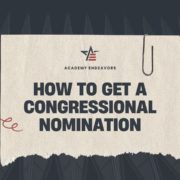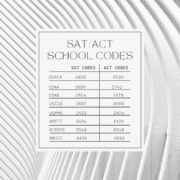How To Get Into the Naval Academy: The Expert Guide
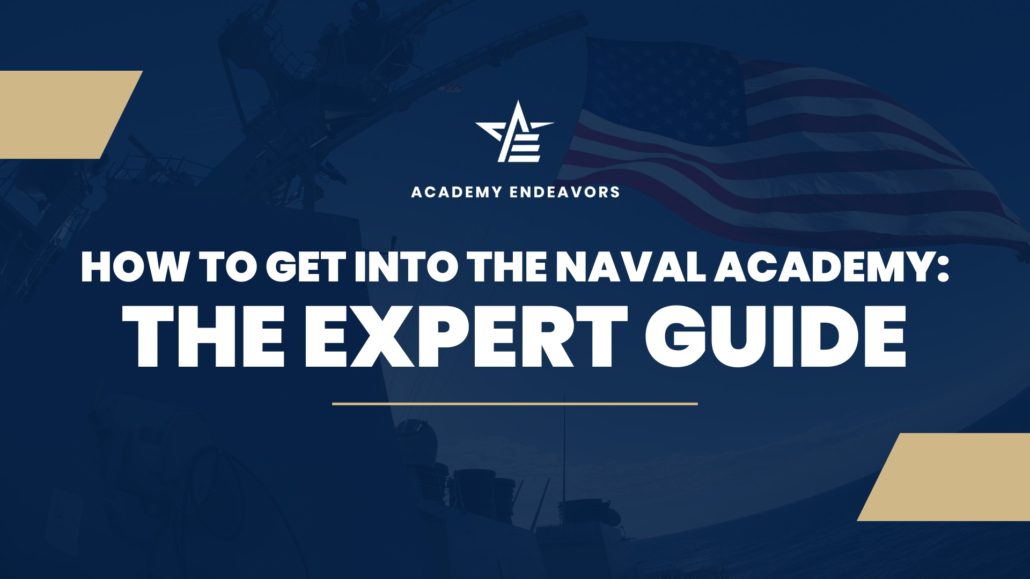
The dream is inside of you. Whether you’ve imagined attending Annapolis since your first Blue Angel air show or a recent visit to “The Yard”, earning an appointment to the US Naval Academy (USNA) will be life-changing.
But that doesn’t change the harsh reality: the application process is complex and hyper-competitive. So many moving parts. The mysterious Congressional nomination process. Nerve-wracking interviews. Curveballs from the medical clearance process. And here’s the worst news: even after jumping through all the hoops, historically there’s only an 8% acceptance rate. Thousands get rejected every year. Only the most competitive, focused applicants will get the coveted appointment.
If you don’t know where to start or where you’re headed, we get it. It can feel like climbing the Appalachian Trail with no GPS. We remember doing our Academy, nomination, and ROTC applications years ago – and the process is nothing like applying to college. Today, applying to normal college is simple: a few essays, the Common App…and you’re done. But with the Naval Academy, there’s no common app. And one mistake could cost you your dream. One missed deadline. One missed email from a staffer. One poor interview that you wished you had back.
But we promise you, if you read these words below, it will change your life. It will drastically improve your chances of acceptance. We’ve seen it happen over and over. Over the last 5 years, 83% of our clients have earned an appointment to a Service Academy. Changing the odds from 8% to 83%…game changer. In 2025 alone, our clients have racked up 67 appointments (…and counting)! Many of them will choose in the coming days to go to Annapolis. So listen up, because if this is your dream, this blog post is your step-by-step guide to getting there.
Because if you do get accepted, you are “set for life.” Academically, you’ll get one of the most prestigious degrees in the world. Financially, you won’t have to pay a dime for tuition, room, or board; your entire 4-year experience will be fully funded by the US government. In fact, you’ll get paid as a midshipman. And professionally, you’ll have every door open to you, inside the military as you rise the officer ranks, and outside the military after you complete your military service.
So, here’s your expert guide to understanding the Naval Academy admissions process more clearly than you ever have before. Time to begin your journey to USNA with confidence.
Who You Need To Be: Candidate Requirements
Candidate Requirements
In order to earn an appointment to the United States Naval Academy, you must be 1) eligible, 2) competitive, and 3) qualified, and each of the components within those 3 categories must be satisfied. The acceptance rate is so low partly because there are more requirements. Normal college doesn’t have a Congressional nomination process, medical clearance process, fitness test, or eligibility requirements, but the Naval Academy does. So, there are more possible points of failure. For example, we’ve seen candidates do everything right, but not get medically qualified. We’ve seen candidates with amazing resumes, but they can’t do a pullup, so they can’t pass the fitness test. Or they’re outstanding students in the classroom but have never played a sport, so they have huge leadership gaps in the “competitive” aspect. The point is, for the whole eligible-competitive-qualified formula to equal an appointment, every component must be satisfied. And that’s what makes the Naval Academy one of the most difficult schools to get into.
Eligible
First, in order to be eligible, candidates must be…
U.S. citizens. NOTE: If you aren’t a US citizen, you can still apply, but you must apply through your home country’s Ministry of Defense.
between the ages of 17 and 22 on July 1st of the year they enter
unmarried, with no legal commitment to a child, and
be “of good moral character”. You could be disqualified based on prior infractions (more on this in the FAQs below).
In order to vet for eligibility, USNA requires you to complete the Preliminary Application (or Summer Seminar application) More details to come, keep reading😉.
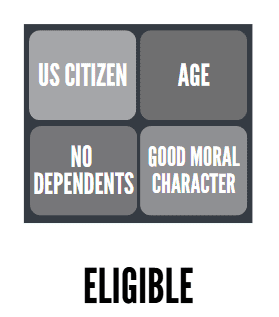
Competitive
Second, in order to be competitive, candidates are evaluated based on their transcript and SAT/ACT scores, teacher recommendations, athletic and extracurricular activities, and fitness test scores, which are plugged into an algorithm called the Whole Person Multiple (see next section for more detail). In addition, candidates are further evaluated by writing essays, and going through an interview, administered by a Blue and Gold Officer (BGO). Phew, that’s a lot! The long list is why USNA consistently gets the most well-rounded young people that the nation has to offer.

Qualified
Third, in order to be qualified, all applicants must do the following:
1) receive a nomination, typically from a U.S. representative or senator, 2) pass a physical fitness test called the Candidate Fitness Assessment, and 3) receive medical clearance through the Department of Defense Medical Evaluation Review Board (DODMERB).

How You’re Evaluated: What Makes You “Competitive”
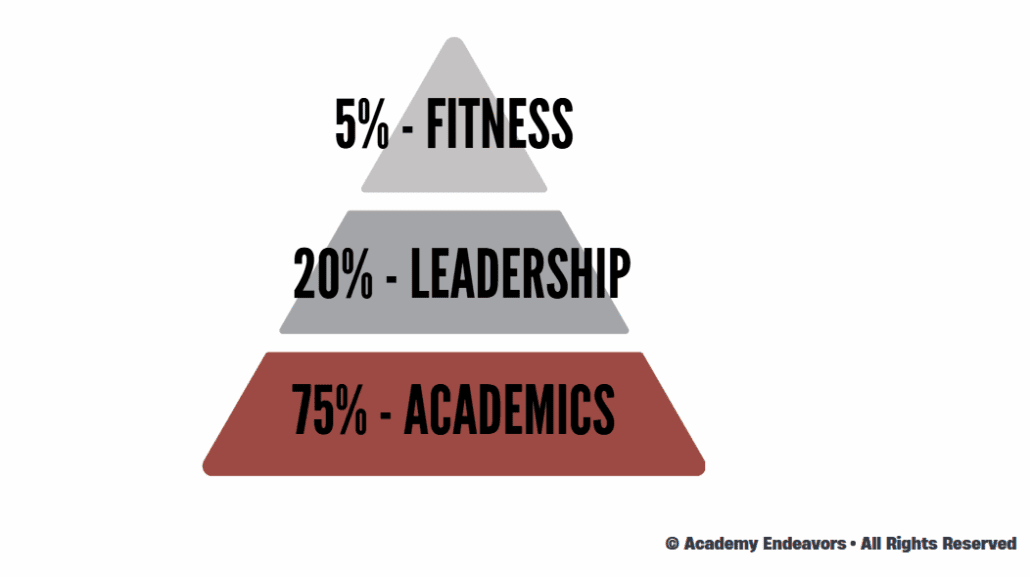
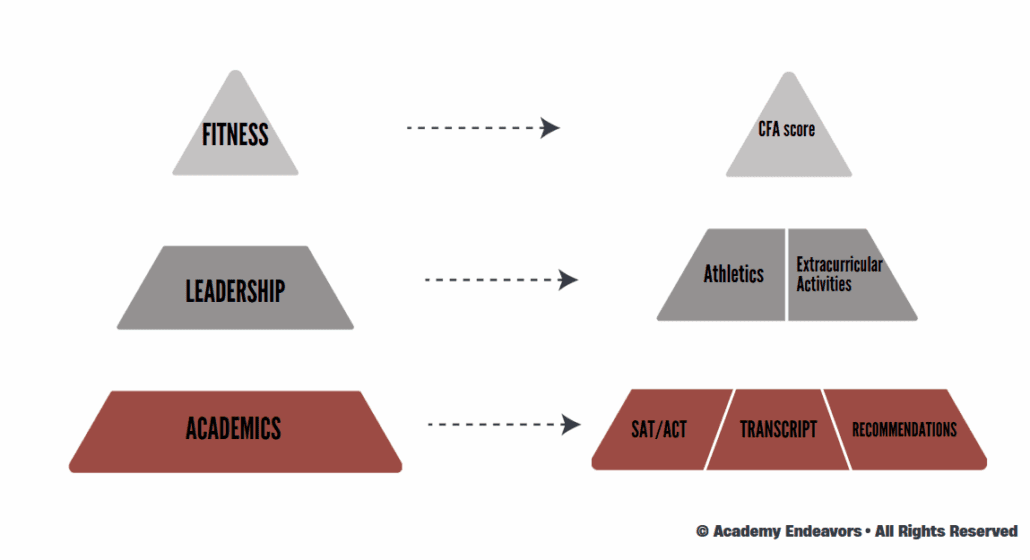
Academics is the largest factor in the Whole Person Multiple Score at 75%. Within this, there are three contributing factors:
- SAT/ACT
- Your SAT/ACT score is the most influential variable, comprising 45% of your Academics score. We cannot overemphasize how often most candidates self-eliminate because they don’t have the score. In the past few years, the mean SAT for USNA was 1380, and the mean ACT was 31. Because recruited athletes are factored into averages and usually bring down the mean from what it would’ve been, we advise to be above the mean, and to not stop taking the test until you know for sure that it’s the best you can do. It’s also important to note that the Academy superscores, meaning they take your highest subsections and combine them into one score, regardless of test date. Superscoring benefits you to take it often, and focus on each subsection at a time, if needed. Bottom line: Take it early, take it often, and take it seriously! For more detail, read our strategy for how to maximize your SAT/ACT score.
- Transcript
- Your transcript accounts for 20% of your Academics score. While your grades/grade point average are important, just a high GPA alone won’t be good enough. The Naval Academy considers four factors, in addition to your GPA:
- (1) Class rank. Your performance compared to your peers matters. Because many high schools don’t reveal class rank to students, Annapolis will ask guidance counselors to unmask your class rank. In 2023, 58% of admits were in the top 10% of their class. Considering recruited athletes take up 20% of the class, you can assume that 58% would jump significantly if recruited athletes were removed. Therefore, getting into the top 10%, although not a requirement, is a worthy goal.
- (2) Course load difficulty. A candidate who earned all A’s but only took regular level classes will be at a detriment. How many advanced classes were made available to you, and if so, how many did you take, and how did you perform? Keep in mind that advanced classes encompass Honors, AP, IB, and Dual Enrollment. It should be noted here that being in pre-calculus by Senior year will put you at least one year behind the applicant pool. Strive to be in the highest level math you can be.
- (3) Competitiveness of your high school. Many people ask us, “if my child has a lower class rank because they go to an elite high school, will that be taken into account?” The answer is yes. Metrics such as “% of students who go to 4-year colleges” will be evaluated when guidance counselors submit the school profile along with the student transcript. On the reverse side, will attending a lower performing high school hurt you? The answer is, perhaps the admissions board will be less forgiving of a lower class rank if that’s the case. The point is, it’s a factor, but it’s one of many, and they look at the whole body of work.
- (4) Performance in specific classes. Your grades in the core math and science classes like chemistry, physics, biology, pre-calculus, and calculus are given more weight than art, religion, and foreign language.
- Your transcript accounts for 20% of your Academics score. While your grades/grade point average are important, just a high GPA alone won’t be good enough. The Naval Academy considers four factors, in addition to your GPA:
- Teacher Recommendations
- Your teacher recommendations comprise the remaining 10% of your Academics score. These need to come from one Math and one English teacher from your 11th or 12th grade years. Here’s how it works: when the official application opens, the candidate will insert their teacher’s email address, and USNA will send them an automated email with a link to complete an assessment of the candidate. The assessment includes a long list of questions, asking the teacher questions that rank their ability in categories such as leadership, character, and academic ability in their discipline. At the end, the teacher can write a typical recommendation letter that provides color to their questions answered. In order to maximize your teacher recommendations score, you must first choose teachers who will be your champion. Don’t give someone the ability to hurt your chances if you know in advance they don’t like you. It’s better to wait and go with a senior year teacher than ask a junior year teacher who you know is a dud. On the other hand, don’t become too insecure and rule out a teacher simply because they are more business-like and you can’t read them accurately. It might behoove you to approach them about your dream of attending the Naval Academy first to get a feel for their support level. Once you identify your recommenders, your next step is to provide them with the resources they need to sing your praises, as well as instructions and deadlines that help them know what to expect.
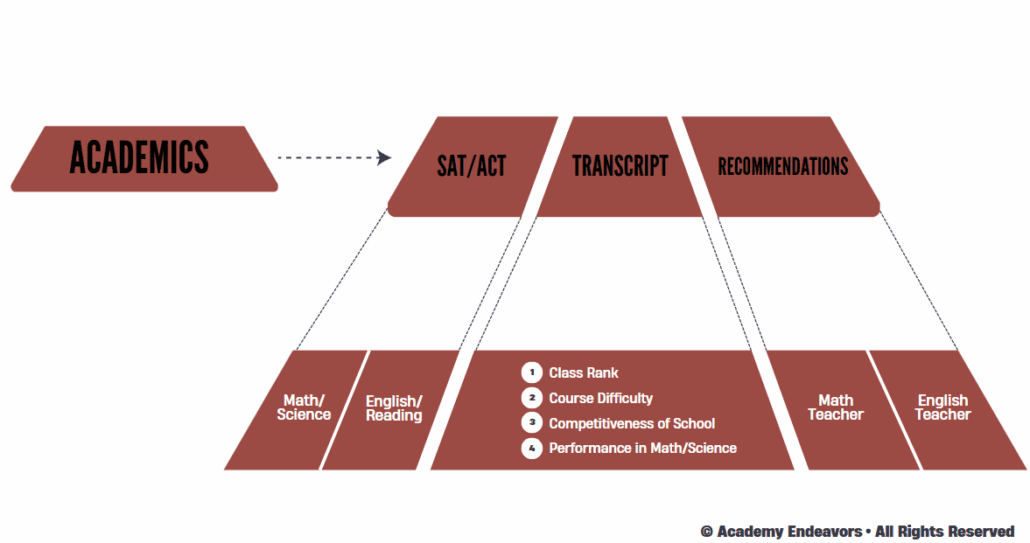
Leadership is the next component in the Whole Person Multiple Score, contributing 20% of the overall score, and it breaks down into 2 categories: 1) athletic activities, valued at 10%, and 2) extracurricular (non-athletic) activities, also 10%.
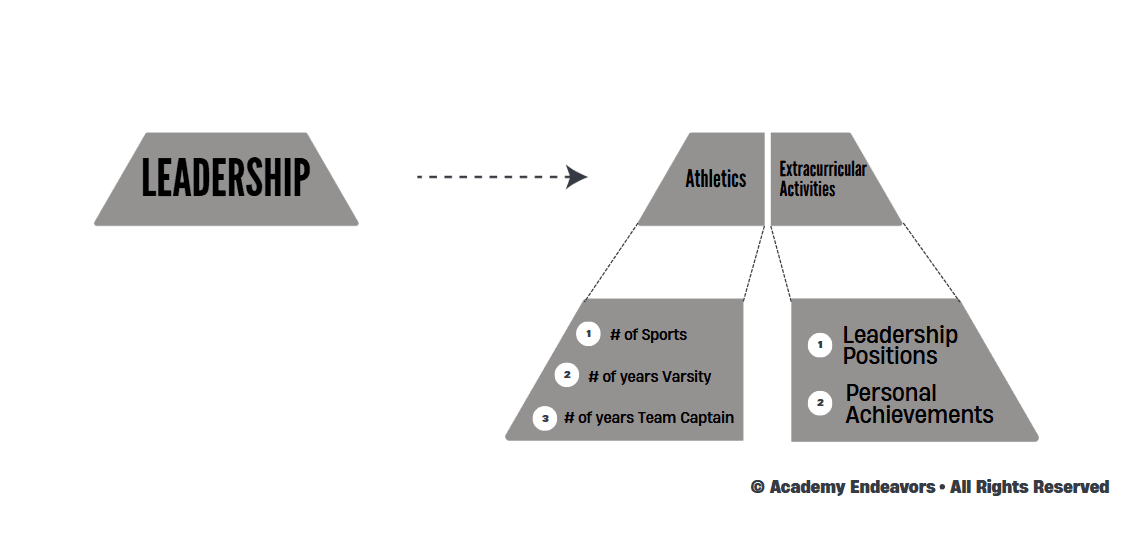
Your athletics activities score has 4 main inputs. If you know the inputs, you can maximize the output.
- # of competitive sports
- # of years Varsity (or varsity equivalent)
- # of years Team Captain
- # of years Special Awards
The more you can maximize those 4 variables, the higher your score is going to be.
Competitive non-school sports, such as club sports and martial arts, can count as equivalent to a varsity letter.
Because there’s a clear distinction in leadership between a team member and captain, the ultimate goal to maximize your leadership points is to become varsity team captain.
Your extracurricular activities score is a huge opportunity because it is the most diverse: it could include non-athletic awards/honors, community organizations, music/fine arts, school clubs, school publications, student government, jobs, and community service. Even though this section only comprises 10% of the Whole Person Multiple, extracurricular activities are where you can differentiate yourself. We find many applicants participate in sports and have good grades, but leadership in all facets is especially attractive to the Naval Academy. Choose your time wisely; invest in activities that have a leadership position available. It may take multiple years to reach your goals to obtain a leadership role, but if you stay disciplined and consistent over time in the right direction, we’ve seen young people score big wins in this category. We recommend you focus on activities that 1) you are passionate about, 2) you are proficient in, 3) have leadership opportunities, and 4) are in recognizable and selective organizations.
NOTE: USNA is the only Academy application that excludes 9th grade accomplishments (as shown in the picture above).
Fitness rounds out your score at 5%. It measures your upper body strength, agility, speed, and endurance and answers the question: can you physically perform? This question is evaluated using the Candidate Fitness Assessment (CFA), which consists of six successive timed events with limited rest in between. You are required to earn a passing score on all six events in order to pass the CFA; however, you shouldn’t just pass it. You want to max each event if possible, so you can improve your chances of admission.
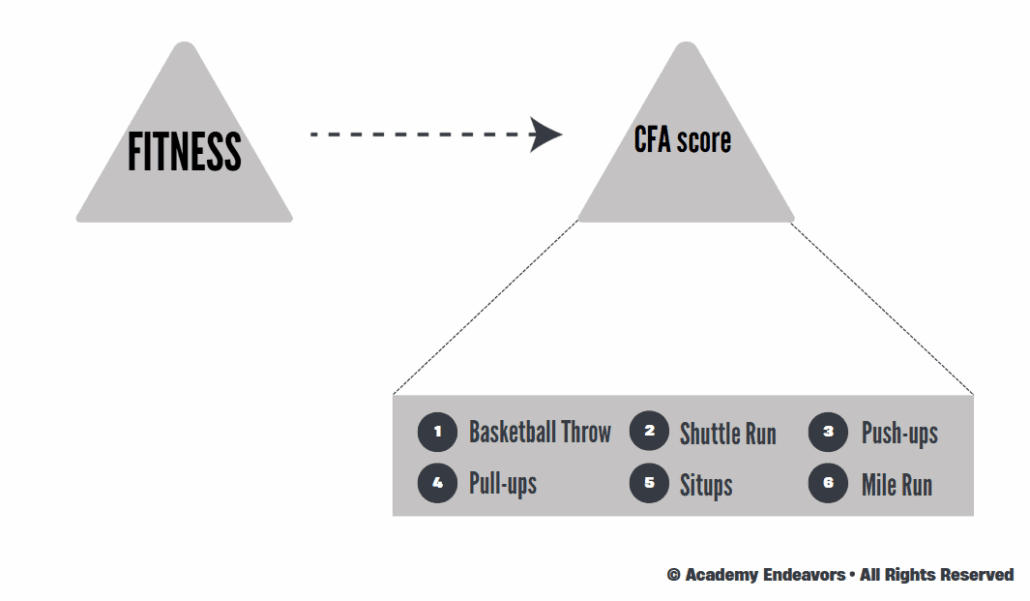
There are a variety of people who can administer the test to you, including a PE teacher, coach, current JROTC instructor, any active duty commissioned officer, or a candidate’s Blue and Gold Officer. Your administrator then submits your score to USNA.
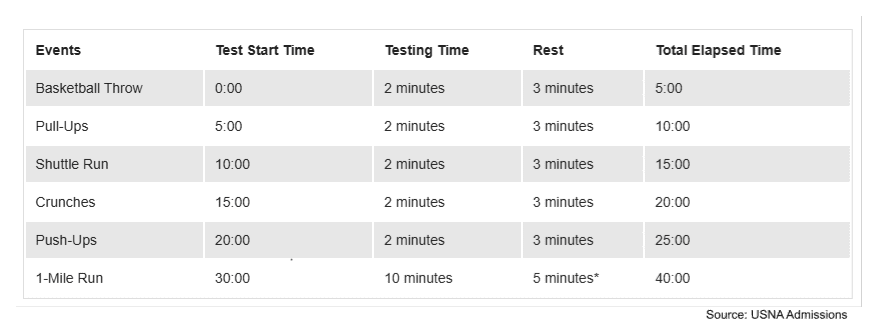
Don’t assume that just because you are an athlete, this part will be easy. Focus, train, and improve! Unlike the other Academies, USNA will accept multiple CFA admissions and are looking for improvement. They’ll happily take your highest score. If you’re curious to know more, you can find USNA’s detailed explanation here.
We recommend you take Mock CFAs to practice and track your progress. You will take your first official CFA at Summer Seminar if you attend. Here’s a link to access a CFA Workout Plan so you can max it!
When Everything is Due – The Path From 10,000 Feet
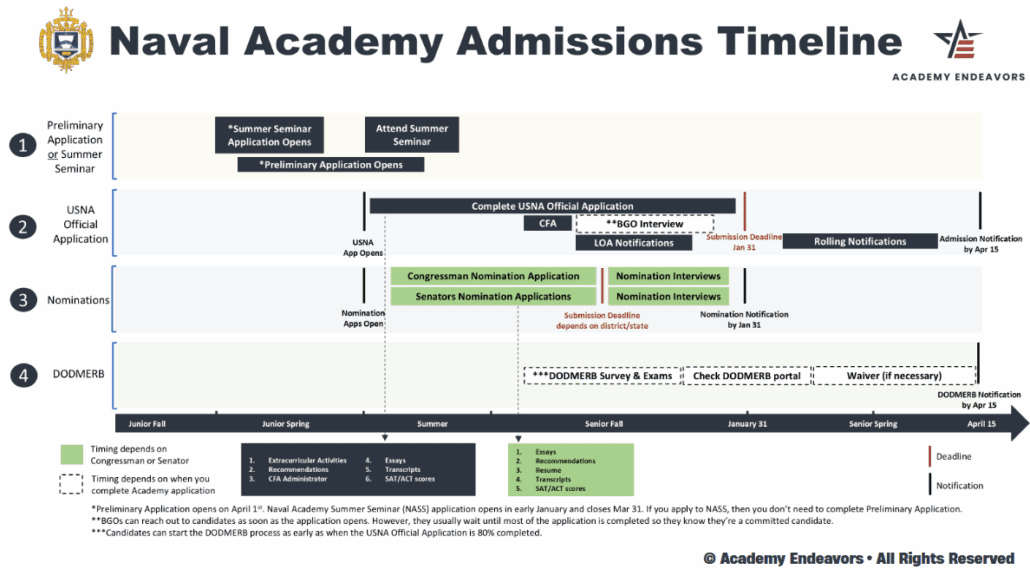
If we begin with the end in mind, all candidates will be notified by USNA of acceptance or rejection on a rolling basis by April 15 of their Senior year spring semester. If all goes right and you are accepted, then you will report for Plebe Summer Induction Day (“I-Day”) at the end of June.
The first step to apply is to verify your eligibility. USNA does this by completing either one of the following: 1) the Naval Academy Summer Seminar application, which opens in early January of your junior year. OR 2) the Preliminary Application, which opens on April 1st of your junior year. Either one of these applications will allow USNA to screen your eligibility, and move you from being a pre-candidate to a candidate.
At the end of your junior year in May, your USNA official application will open, and you must submit your USNA application by January 31 of Senior year. The application includes your essays, activities list, recommendations, candidate fitness assessment, high school transcripts, SAT/ACT scores, and Blue & Gold Officer interview (more on each of these later).
However, after completing the USNA application, you’re still not done. The application process is so complex because there are 2 equally important processes that run in parallel: 1) your Congressional Nomination applications, and 2) the DODMERB medical clearance process.
The Nomination applications deadlines vary by state and district. You can find those on each of the Congressional and Senators’ websites. The likelihood is, they will be due between September and December of your Senior year. After submitting those applications, most elected official’s offices will conduct interviews to make final determinations for nominations, and decisions are released by January 31. You are also eligible for the Vice Presidential nomination, which is due by January 31.
The DODMERB process starts after you’ve completed the majority of your USNA application. Once the DODMETS portal opens (more on that later), you’ll complete a medical history survey, attend physical exams, and find out if you’re medically qualified by April 15.
Bottom line: to get into the Naval Academy, there are 7 applications, each with different deadlines: 1) USNA Preliminary Application (or Summer Seminar), 2) USNA Official Application, 3) Congressman nomination application, 4) Senator 1 nomination application, 5) Senator 2 nomination application, 6) Vice Presidential nomination, and 7) DODMERB application. NOTE: On top of this, most candidates also apply for the NROTC scholarship as a backup option.
There are lots of moving parts!!! So, let’s start by attacking each one. But first, a tangent about why you should submit your application early.
Why You Should Submit Your USNA Application Early
Reason #1: LOAs. We mentioned earlier that the Naval Academy uses rolling admissions. Contrary to most colleges, Annapolis doesn’t notify everyone on the same date whether they are accepted or not. So, the date you turn in your application is important. The reason: USNA gives out a limited number of LOA’s in the fall (typically, September thru November), only to those who have completed their application early. LOA = letter of assurance, which is a conditional appointment, contingent upon getting a nomination and medical clearance. You see, at the time when they give out an LOA, USNA cannot legally give an appointment because you don’t have the nomination secured yet. So, for the best applicants, they will offer an LOA instead, so that USNA can compete with other colleges for the best applicants.
The admissions board meets weekly from September thru May. Your ideal goal is to get your application in before the first board, get the LOA, and have peace of mind going into your Senior year that the hardest part is behind you.
Who is a typical LOA candidate?
- 1400+ SAT/32+ACT
- Top 10% of class
- Multiple leadership positions
- Multiple athletic activities
- Outstanding BGO interview
- Outstanding essays
Reason #2: Senior year peace of mind. The fall of your senior year will be the busiest time of your life. We see it every year in the October time frame: your new leadership positions, AP/Honors class workload, college applications, ROTC applications, and Congressional nomination interviews all converge into one and blow up your calendar. The game is to eat this elephant one bite at a time, so that you are doing high quality work in a timely manner. If you don’t get ahead of it by doing significant work over the summer, the tidal wave will come and you won’t be able to do your best work. But if you have the discipline to focus over summer, your Senior year will feel much more focused and free. This is why we have Bootcamp for our Pro clients – to attack all the deliverables over the summer, so that they can have peace of mind during their Senior year that they crushed the most complex part first.
Reason #3: DODMERB Clearance. The DODMERB process can take a long time, and 20% each year are disqualified and in need of a waiver. If you are the unlucky 20%, then waiting to submit your USNA official application until the last minute puts you in a pickle if you have to get doctor’s appointments and extra medical records. Watch our video on DODMERB Strategies to get Medically Qualified.
Now we’ll return to our detailed look at each of the steps you’ll take to land that coveted appointment:
Step 1: USNA Preliminary Application or Naval Academy Summer Seminar Application
Your first step involves a choice. Do you want to apply to the Naval Academy Summer Seminar (NASS) or not? If you do, it acts as your preliminary application and step 1 will be complete. NASS is a six-day session at Annapolis where you get to experience the life of a midshipman. The Dean of Admissions has stated there are no extra points granted to those who attend NASS, so don’t apply in order to impress. The main motivation for attending NASS is to experience the Yard (if you haven’t already) and verify that the Academy life is for you. We’ve found most of our clients come back with fire in their belly to complete the application process with tenacity, and are able to add a few nuggets to their essays and interview answers! So, there is an intangible benefit to attending NASS. If you wish to apply, applications open around Jan 1st and close March 31st of your junior year (it is for rising Seniors only).
We’ve found over the years that the main reasons young people get into NASS are:
- outstanding academics and leadership: if you already have an “above the mean” SAT/ACT score (many don’t yet when the application opens), then that’s a huge differentiator. If you already have some outstanding leadership positions (again, many don’t have this when the application opens because it’s only the middle of junior year), then that’s a huge differentiator as well.
- live in underrepresented districts: if you live in a targeted area, you have a greater chance of acceptance because USNA wants to use NASS as a recruiting tool to attract areas that they’ve had a difficult time reaching.
If you are not applying to NASS, then you must complete the Preliminary Application (start here: https://www.usna.edu/Admissions/Apply/, then click “apply”). There’s no “strategy” here: it’s a simple application to verify that you are eligible to apply (see the 4 factors mentioned above in the Candidate Requirements section). We estimate that 95% of applicants advance the Preliminary Application to candidate status. Preliminary Application instructions are here.
While we’re on the topic of to-do’s during second semester Junior year, it’s important to mention two things as an aside:
First, you might receive an invitation to attend Candidate Visit Weekend (CVW), starting around this time. If so, CVW is a great opportunity to see the Yard if you don’t attend NASS. Similar to NASS, it’s not an evaluation tool to assess future applicants; instead, it’s a recruiting tool for USNA to attract candidates and showcase all facets of life as a midshipman. Find all the details, including a detailed itinerary of the weekend, here.
Second, we highly recommend you apply to Boys State or Girls State, a week-long summer leadership program for rising seniors. Run by the veterans at the American Legion, the purpose of the week is to instill an appreciation for democracy and civil service. Boys or Girls State is not partisan at all; instead, it’s a fantastic opportunity for confidence building, leadership development, networking, enhancing your USNA application, and personal growth. Google your state + Boys or Girls State, and click the first thing that comes up; each state has their own application. It scores huge points for Naval Academy applications.
Step 2: USNA Official Application
Naval Academy applications are open as early as mid-May, and, as we’ve recommended, complete yours early to maximize your chances of receiving a Letter of Assurance and medical clearance, as well as giving you peace of mind going into your senior year. Plan to commit a significant amount of time during the summer to preparing for and completing your application.
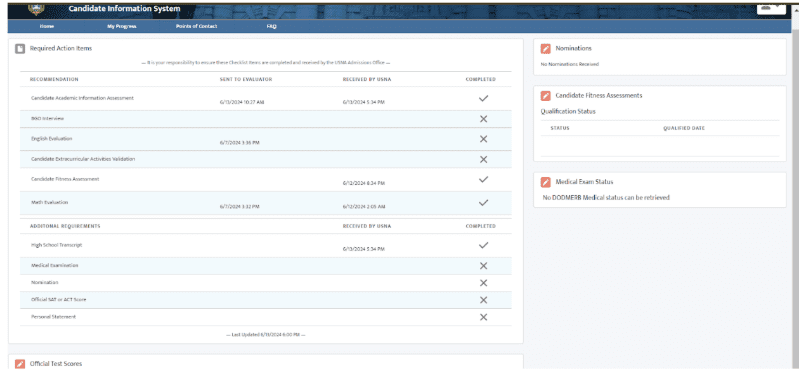
The application starts off with personal information, demographics, academic records, etc.
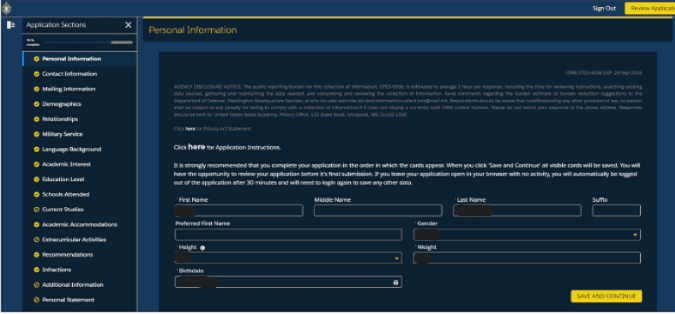
However, several sections will require advance preparation and intentional planning.
Extracurricular activities
Consider this as USNA’s version of your resume. Every extracurricular activity and leadership role must be entered thoughtfully and accurately in order to earn points toward your Whole Person Multiple. Include anticipated activities/awards/varsity letters that you project to participate in or earn during your senior year as well (yes, USNA does allow this).
Click the save button regularly. It is located in the bottom right of the application. Save, save, save! You don’t want to lose any of your progress.
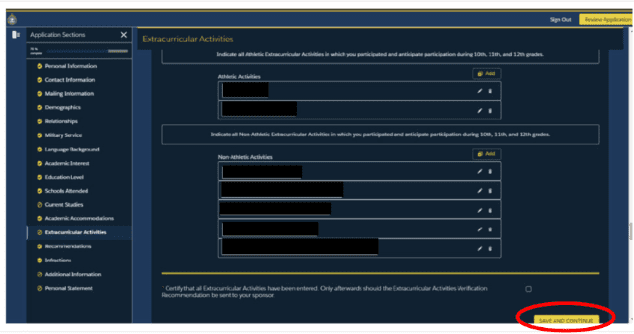
If one of your activities doesn’t show up on the list, there is an option called “other club/activity” that you can choose.
Be thorough! If you forget to enter an activity, you’re risking a big loss due to a silly mistake.
Recommendations
Build rapport with your teachers and speak to them about recommending you, so that when you enter the email addresses for your teachers of choice, they aren’t caught off guard. After you enter their email address, check with them to ensure they received the recommendation email and that it didn’t accidentally end up in spam. In addition, you’ll be entering your guidance counselor’s email address so they can upload your transcript (called the “Academic Information Recommendation”) and verify that your extracurricular activities are correct (called the “Extracurricular Activities Verification Recommendation”). Additionally, USNA also allows you to insert up to 3 optional “Other Recommendations” from whoever you wish. You never want to waste an opportunity for someone to talk you up! Use all 5 recommendations (math, english, and 3 optional) to build the strongest case possible for your acceptance.
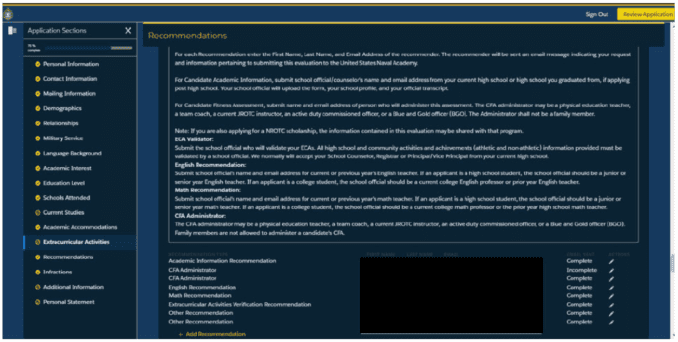
Candidate Fitness Assessment
The Recommendations section is also where you enter the email address of the person who will administer your Candidate Fitness Assessment. After you enter their email, they should get an automated email (remember, ask them to check spam).
A few items to note…
First, remember that the Naval Academy accepts unlimited attempts on the CFA. Keep taking it until you’re 100% convinced it’s your best score, and you can submit better scores up until Jan 31.
Second, if for some reason you perform poorly (due to sickness, mishap, etc), then tell your administrator not to submit it and instead reschedule with them.
Third, watch our video on how to max your CFA!
SAT/ACT scores
To submit your SAT/ACT scores, the USNA SAT school code is 5809 and the ACT school code is 1742.
We recommend you submit only the test scores that involve your superscore.
Log into your portal often to view your Required Actions List and ensure USNA actually receives your scores. If you sent them and USNA isn’t showing them as “received”, then contact your USNA Regional Admissions Counselor in your portal.
The Naval Academy also allows you to submit updated SAT/ACT scores after you complete your application. December of the year you apply is your last opportunity to take the SAT/ACT.
Just like the CFA, keep taking it until you are 100% convinced it’s your best. Otherwise, you’re leaving points on the table!
Personal Statement
USNA requires a written two-part essay, limited to 4000 characters total, followed by several optional short answer essays. Keep in mind that the character limit is not a suggestion and that the application will not submit if you are over the limit. So be intentional about every word.
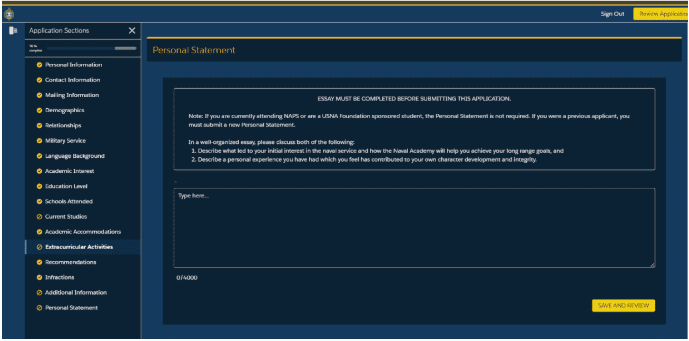
The USNA essay prompt states:
Part 1: Describe what led to your initial interest in the naval service and how the naval academy will help you achieve your long-range goals.
Part 2: Describe a personal experience you have had which you feel has contributed to your own character development and integrity.
Want a winning essay? Use these tips as your guide:
- Your essay should be (a) personal to you, (b) specific to USNA, and (c) reflect genuine enthusiasm and heart.
- Consider starting with a hook to grab the readers’ attention. Thousands of essays have been submitted that begin with the phrase, “I’ve wanted to attend the Naval Academy since _.” Craft an opening sentence with personality!
- Next, set up the story of how your desire to serve blossomed over time, including the specific steps you’ve taken to act upon your interest in a clear, chronological sequence. You’ll conclude this portion with your intended major and future career goals, being sure to emphasize the key Navy values of honor, courage, and commitment.
- Choose a STAR story for part 2 – a formatting tool that lays out a meaningful story arc:
- The Situation allows you to give background and set the scene.
- The Task presents a problem or obstacle that needs to be overcome.
- The Action describes how you went about solving the problem.
- The Result lays out the effects of the actions and what was better because of it.
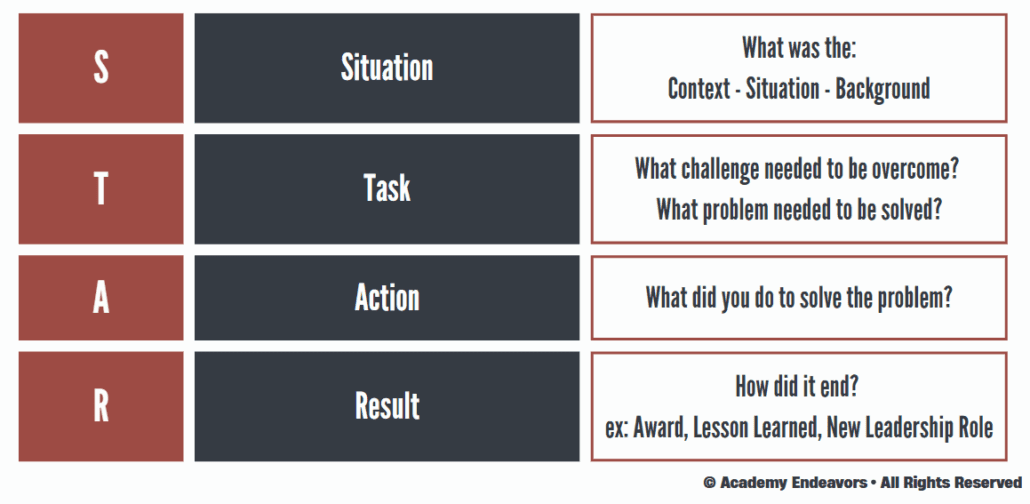
- Use an appropriate transition sentence into Part 2. Then, your STAR story should demonstrate maturity, integrity, and growth. Ideally, it made an impact on people outside of just yourself. Even better, the resulting growth or lesson learned could be applied to your future at the Naval Academy.
Optional Essays
There are 5 short, optional essays that are only 255 characters. They focus on foreign language experience, cultural heritage, overcoming adversity, unique life experiences, and family socioeconomic background. Spend quality time on these as well; as we’ve mentioned, never pass up on an opportunity to share more about yourself and how you’ll be a good fit for USNA.

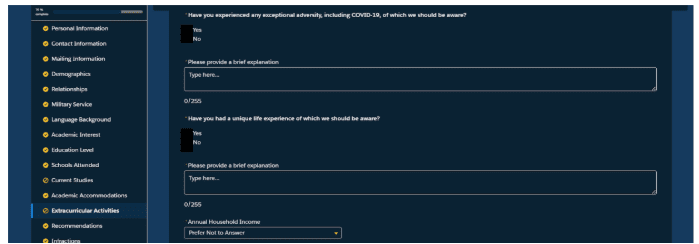

BGO Interview
The Blue and Gold Officer assigned to you usually will reach out to you to schedule an interview after he/she sees that you’ve completed a majority of your application. The reason is, they don’t want to pursue the candidate if they haven’t demonstrated first the desire to complete the application. However, please note, this is not always the case; there are hundreds of BGOs, and we’ve seen them act independent of each other, so you must be ready for when they do reach out, which is another reason to get the application completed early! Besides, you will want to connect with your Blue and Gold Officer prior to the interview to introduce yourself and begin to develop a foundation of rapport (see appendix). Send a professional email, schedule a phone conversation, or make a plan to meet for coffee. This is your opportunity to demonstrate maturity (opting for more than just a casual text, using “sir” or “ma’am”, etc.) and a desire to learn and grow (ask thoughtful, open-ended questions about your BGO’s time in the service and seek their advice on next steps.). 40% of applicants will have their first interaction with their BGO at the official interview, but not you. The relationship you’ve built with your BGO will build credibility and give you a boost of confidence you can take with you into your interview.
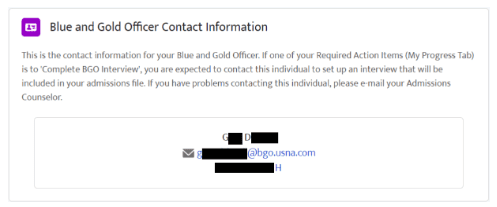
If you are finished with your application, and you haven’t heard from them yet, we recommend you reach out with a professional email to get the ball rolling.
Once you do get to the interview, the BGO interview will evaluate you based on six categories:
- Interest and Motivation
- Responsibility
- Physical Fitness
- Leadership Potential
- Organizational Skill
- Oral Communication Skill
You’ll want to come prepared to answer questions within each category, but your main overarching goal is to come with a clear understanding of your reasons to serve as well as personal stories that reveal your fit qualities. After the interview, your BGO will do a write-up and rank you in one of the following categories (top 5%, top 25%, above average, average, below average, do not recommend), which is then sent over to the Naval Academy admissions for consideration.
Download our BGO Interview Guide so you can crush it!

Step 3: Congressional Nominations Applications
The summer before senior year is when Congressional nomination applications open (generally May to August). Remember that a Congressional nomination is a requirement for admission, and you will complete a handful of applications (as well as an interview for each!) in your pursuit of landing one. Though these aren’t due until the fall, you want to commit time over the summer to getting the nomination process started. Here’s an overview of how it works:
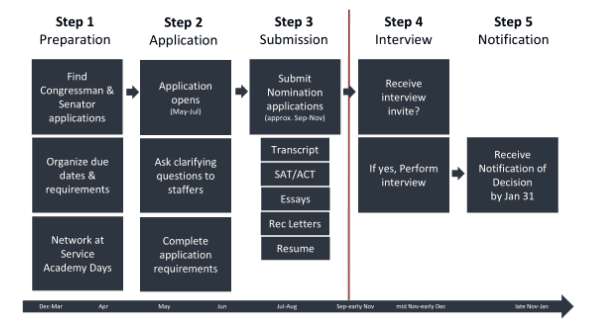
- You can receive a congressional nomination from any of your elected members of Congress (state representatives from your home congressional district or your two senators) or the Vice President of the United States. Find out who your Congressman is here.
- Members of congress can nominate up to 15 people per Academy, so your likelihood of getting nominated depends significantly on how many people apply in your district (think 10 out of __, and the greater that second number, the lower the percentage).
- You do not need to know any of these sources personally, and you are encouraged to apply to more than one. Every source has its own deadline, however, so be sure to pay careful attention to the timelines on their websites.
- One way to increase this percentage is to list USNA as your number one choice when you list Academy preference order on your application. Some members of Congress will only nominate for your top listed Academy, so this certainly worth considering.
- Additionally, by law, the Academy must offer at least one appointment per district, assuming there is a qualified applicant. So, if you win your district, you can be on your way!
For more detail, read our blog post: How to get a Congressional Nomination.
Congressional Nomination Interviews
Finally, Fall of senior year is the season for Congressional nomination interviews. Again, you cannot receive a USNA appointment without a nomination, so you’ll want to prepare for these with thought and intention. There will be one for each congress member with which you applied, and they often involve a panel of listeners. Dress professionally and use the interview skills you already honed for your BGO interview. You know how to do this now.
For more detail, watch our video “Strategies to Crush Your Congressional Nomination Interview”
Step 4: DODMERB Medical Clearance Process
The DODMERB medical clearance process is extremely confusing, so we have mapped the process in an 8-step flow chart below. Bottom line: if you’re not medically qualified, then USNA isn’t allowed to offer you an appointment…so listen up!
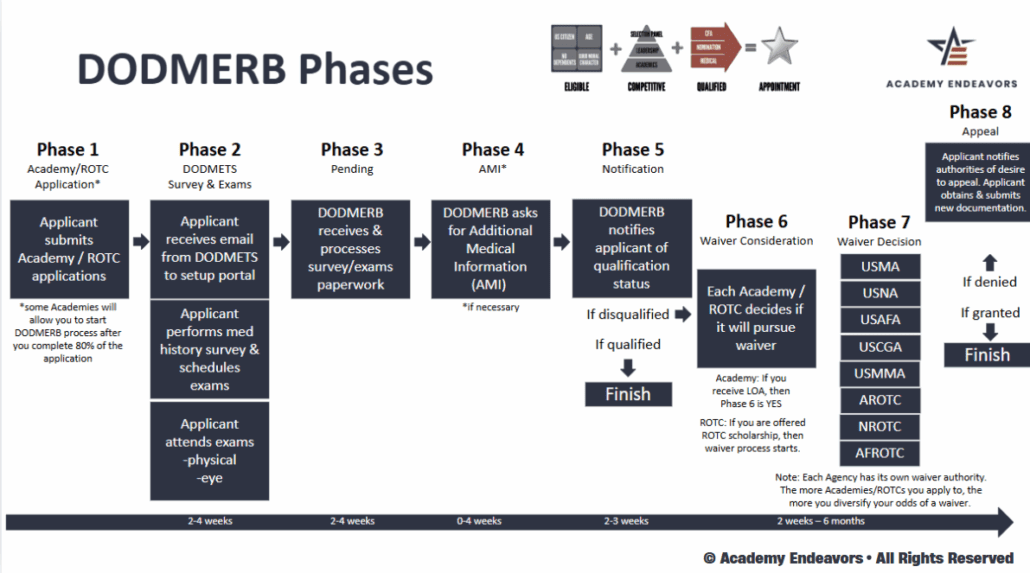
Once your application is approximately 80% or more completed, it will trigger the Naval Academy to send your information to DODMERB so you can start the medical process. USNA needs to see that you’re a serious applicant intending on completing the application, which is why they wait until a majority of it is completed. To kickstart the process, you’ll usually receive an email from DODMETS, which is the Department of Defense contractor that administers exams on behalf of DODMERB. If you do not receive this email (which, truthfully, sometimes happens), we recommend you go to www.DODMETS.com to try to set up your portal using your social security number (you’re looking for “applicant login”!). First time users login using their SSN with dashes as the username and their last name as the password.
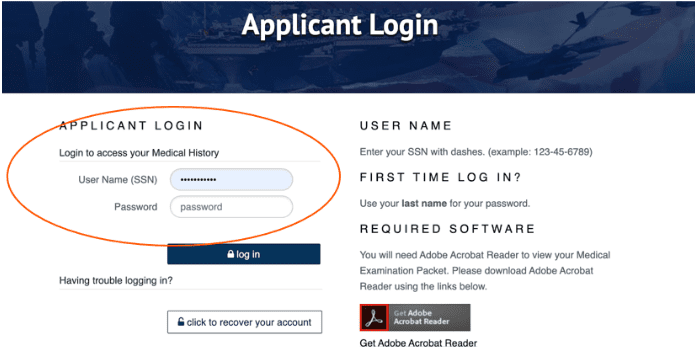
After inputting your initial information, your next step is to complete the 113-question medical history survey. We highly recommend you do this survey with a parent because one mistake in the survey could open “Pandora’s box” and cause downstream problems if you answer inaccurately! The questions cover literally every organ system in your body; it is extremely comprehensive. Please note that the survey will force you to “save” answers along the way and, once items are saved, they cannot be edited! So be sure to go slowly and carefully. Here’s a copy of all the medical history questions, so that you can go into it prepared. Whichever questions you answer “yes” to in this survey, you should pull medical records (and read what the doctors wrote!), so when the DODMETS survey opens, you are ready to answer accurately.

Next, you will be prompted to schedule eye and medical exams, which will be local and free to you. Call and make your appointments for the closest available date.
After the exams, DODMETS will send your medical history survey and exam paperwork to DODMERB, and you will have 2-4 weeks to wait while they process the paperwork. The one action step needed in this phase is to set up your DODMERB portal to find out whether you are medically qualified or disqualified. Go to https://dodmerb.tricare.osd.mil/ and click “register”.
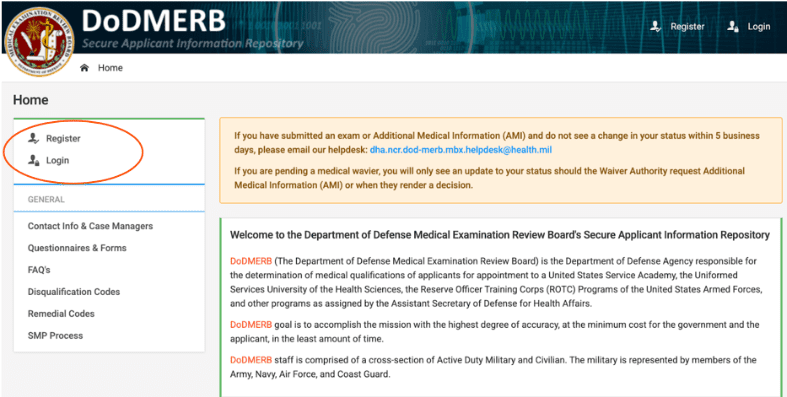
You will be notified in your DODMERB portal if additional medical information is needed and if you are qualified. Pay attention to your email and your DODMERB portal, so you don’t miss something that needs your attention.
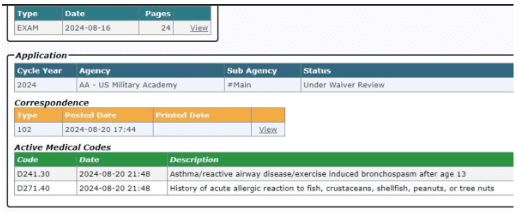
Once your DODMERB portal says “Qualified” (as shown below), then you’re done! Mission accomplished, you are medically qualified.

Where You’ve Been: A Review
Pictures are worth a thousand words but this diagram might be worth more. To summarize:
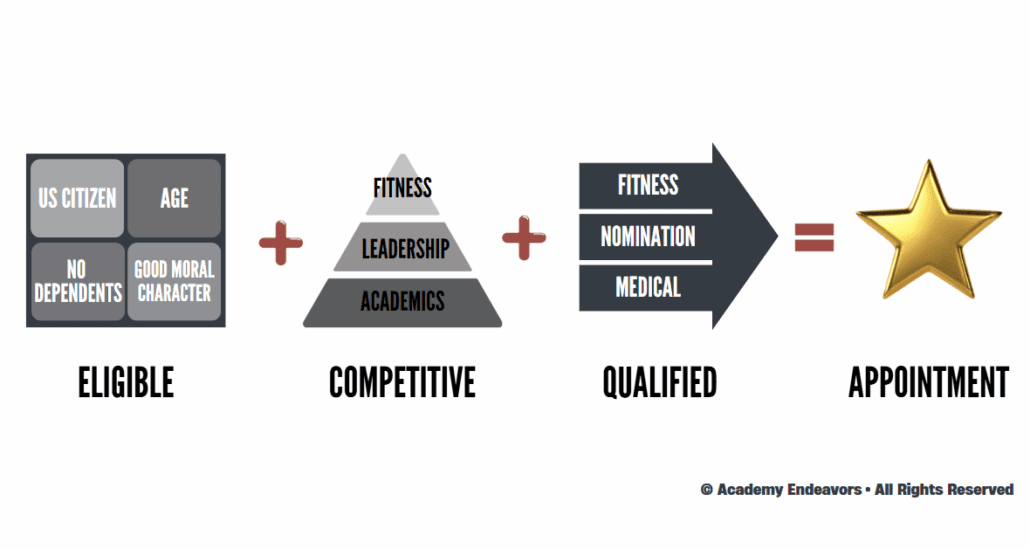
12,000+ people go for that gold star appointment every year, but only 1,200 get the prize! What are you going to do differently than the other 92% that aren’t successful? If you do everything we tell you above, you will drastically increase your odds of an appointment! Our clients have followed this blueprint and 83% of them have been successful. We’d recommend you reach out to Academy Endeavors for a free consultation so we can help you determine your next steps. There’s no shortcut to success; it takes real work. But the journey is possible. A USNA appointment awaits the best of the best, and you’re certainly reflecting that by being here – after all, it’s those with honor, courage, and commitment who seek out knowledge to chase after their dreams. We’re cheering for you every step of the way – the Naval Academy awaits!
Case Study #1: Jake
Jake came to us from a tough Congressional district where many Academy applicants get in each year. Our work began with a 360 assessment of his strengths and weaknesses on a one hour call, during which we charted out his goals and milestones on a structured schedule. We did a deep dive with him into his transcript, SAT plan, fitness prep, medical history, Congressional district data, and an analysis of which extracurricular activities would look most attractive to admissions.
We gave him a straight-forward syllabus of next steps, along with the schedule for the meetings, which included resources for completing his essays, returning them for edits, and crushing his mock interviews. He also performed mock CFAs before each meeting.
This prepared him perfectly for Bootcamp, a 2 week catalyst to get every application over the finish line in a high quality manner.
The result: Jake turned in his Academy, ROTC, and nomination applications early by Aug 31, earned Congressional nominations, two LOAs to USAFA and USNA, and ultimately chose USNA for his future. We couldn’t be happier for him and his family!
Case Study #2: David
David reached out to us because his family had no military background and were overwhelmed by the Academy application process. During the discovery call, his parents’ words were, “Tthis is our son’s dream, and we don’t want to screw it up.” We jumped in with a 360 assessment and got to work. Like most, David struggled with knowing where he stacked up and what his weaknesses were. We set goals with clear milestones, delivered a clear syllabus to show him the next steps, and stayed with him throughout the application journey. At each meeting, we followed up on goals, delivered timely feedback on essays and interview prep, assessed progress on his fitness, followed up on medical records needed to pass DODMERB, and stayed on top of deadlines for nominations.
The result: David submitted high quality, polished applications early to the Academies, jumped through the hoops to get a Congressional nomination, and after 15 months of work with us, he earned his dream appointment to Annapolis! The Navy got one of the best kids in the world!
So, what’s your story going to be? Where will this journey take you? We’d love to hear from you! Reach out for a free consultation so we can help you determine your next steps and champion you to achieving your dream!
Frequently Asked Questions
- “I’m only a freshman or sophomore. What should I be doing now to prepare myself?”
- Answer: Watch our video for underclassmen called How To Prepare.
- “Does the Naval Academy prefer the SAT or the ACT?”
- Answer: There’s no preference between the two; USNA accepts both. About 50% of candidates do the SAT and the other 50% do the ACT. Choose the test that best fits your ability.
- “I’m not a US citizen, but I want to go to the Naval Academy. Can I still apply?”
- Answer: If you’re NOT a US Citizen, then you can still apply, but you have to go through your Ministry of Defense’s website in your home country and apply as a foreign national. And there are only 15 slots per year to each Academy.
- “I’m a college senior and just realized that I want to go to the Academy. Can I still apply?”
- Answer: If you turn 23 the summer you’re in-processing, then no, you’re too old. If not, you can apply.
- “I live overseas but I’m a US citizen. Can I still apply?”
- Answer: Yes, overseas US citizens are still eligible. The challenge comes with where you have residency. If you don’t have a US domicile, then you aren’t eligible for a congressional nomination, you are only eligible for the VP nomination.
- “I smoked marijuana in high school. It was a dumb decision, and I didn’t do it again. Can I still apply?”
- Answer: The answer is yes, most likely you can still apply. We’ve had clients confess to that, and they’ve been asked to write a personal statement regarding the situation. Admissions reviews the story and makes a determination, and depending on the severity of the situation and remorse of the applicant, it can be viewed favorably.
- Bottom line: I wouldn’t let an infraction stop you from at least attempting to apply, depending on the severity. But know that West Point, Naval Academy, and Air Force Academy have places in their application process where you’re gonna have to answer to it. There are a few places that you will be asked to provide a personal statement on whether you used or experimented with illegal drugs.
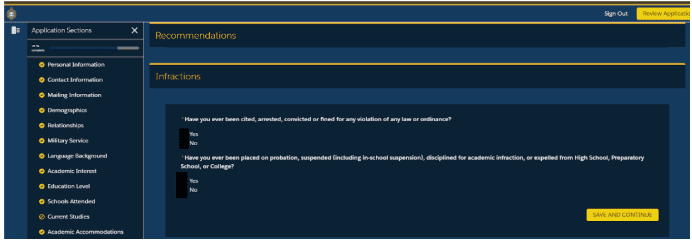
- “What about club sports?”
- Answer: Competitive clubs are counted as varsity equivalent. In addition, black belt in martial arts is varsity equivalent.
- “What if I haven’t played a sport yet? Can I still get in?”
- Answer: You significantly hurt your chances, but it’s not impossible. We’ve had a handful of clients who were exceptional in everything else but didn’t play a sport, and they still got in. Doing worse in one area means you have to be more exceptional in every other area.
- ”I haven’t played a sport yet. Is it too late?”
- Answer: No! We’ve had clients late in the game go out for other sports in high school and make varsity. Typically those are low skill sports such as track and field or cross country. Or non-traditional varsity sports that have lower participation such as varsity skiing or badminton.
- We’ve also had clients go out for club sports in their community such as rugby or mountain biking. The point is, don’t let athletic activities be blank in your application. And extra points if you can make an impression and be a team captain!
- “What if my coach doesn’t have team captains?”
- Answer: See if your coach will make an exception. The worst they can say is no. Give your coaches context for why you’re asking the question. Spin it to the positive and tell them you want to make a bigger impact on the team and practice more leadership skills because you want to serve your country as an officer one day. I don’t know a coach in America that wouldn’t respect a young person with that mindset.
- “I’m the Officer of XYZ Club. How many points is it worth?”
- Answer: While no one knows how many points each thing is worth, we know the 3 components of the most significant leadership roles. The best leadership roles are in recognizable organizations (if the Naval Academy has never heard of the club, it’s gonna be a harder sell compared with leading something like Key Club, which is a national organization and has been around for years). In selective organizations (the more selective ie. elected positions, the more points), and peer-led (ex. if you’re leading 2nd graders as a camp counselor, that’s not as valuable nor as applicable to the military as leading peers in Student Council).
- “Which activities should I get involved in? Or, said another way, should I switch from activity A to activity B?”
- Answer: Our advice depends on the following:
- Which ones have leadership roles available? What’s the probability of getting one? Are they already all taken, or is there an opportunity?
- What’s the time commitment? Does it fit in my schedule, and what will I have to give up to get it?
- Recommender at stake. Will this change who you ask as a recommender?
- Bottom line: Get on a path to get leadership roles. If you’re gonna do it, lead it.
- Build off what you’re already doing. Prove yourself over time and then get elevated to a bigger role. Don’t just be a Member
- Create your own club.
- Answer: Our advice depends on the following:
- “How competitive am I?”
- The answer will be determined by how strong your academics, leadership, and selection panel score is. We’d recommend you reach out for a free consultation so we can help you determine your next steps.
Acronyms
BGO: Blue and Gold Officer: Blue and Gold Officers work for the Naval Academy as admissions field representatives. Their main role is to perform the official application interview so that USNA ensures its getting the best candidates. You don’t get to choose your BGO; they are assigned by geographic area. You can find your USNA Area Coordinator’s contact information here, and he/she will connect you with the BGO assigned to your specific school.
CFA: Candidate Fitness Assessment, administered to every applicant to measure physical fitness capabilities
DoDMERB: Department of Defense Medical Examination Review Board, the government agency in charge of determining if an applicant is medically qualified for military training and service
LOA: A Letter of Assurance is a conditional offer of admission to the Naval Academy given (early!) to top applicants; this secures your spot, assuming you obtain a nomination and DODMERB medical qualification.
USNA: The United States Naval Academy, one of five service Academies in the United States. The Naval Academy prepares midshipmen for service in the U.S. Navy and U.S. Marine Corps, and is located




